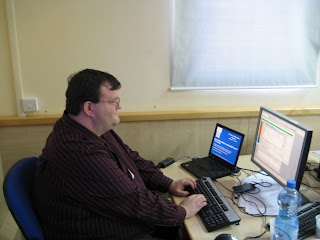January finds me again in Oman, one of my favorite places, and teaching, one of my favorite jobs.
 |
| Burney teaching gas lift |
 |
| Larry Peacock of AppSmiths Ventures, LLC |
 |
| The coast of Muscat, Oman |
 |
| Gas lift class in Oman |
This weekend I wrote a draft of a new gas lift test for the course. Here are a few of the topics covered on the course and the test:
Gas Lift Competency
- Why gas lift is able to increase or sustain production
- What factors increase production into the wellbore through the completion zone
- How pressures in the tubing are influenced changes in produced fluid characteristics and mechanical changes to the well
- How the two primary methods of gas lift work and when to select each
- The three main gas lift objectives for gas lift, in order of importance
- The benefits and problems of gas lift
- The primary operational hazard that causes gas lift valves to fail prematurely and how to avoid this
- The relationships of pressure, volume and temperature on gasses and how to apply these relationships in gas lift analysis and design
- How the density of certain fluids change and how to estimate pressure at depth for various fluids
- How gas is most commonly measured and the most common reasons for poor measurement
- How to calculate the amount of gas that can go through a valve, what factors affect this rate, and how to size valves for a given gas throughput
- How to estimate the lift depth of a well from a flowing survey, from surface pressures, from valve mechanics and/or from valve throughput,
- The effect of well surging on welltest and pressure survey measurements
- The four main causes of well surging and how to recognize and eliminate each
- The main types of gas lift valves, how each of these types work, how they are installed and retrieved,
- The primary mechanisms by which gas lift valves fail over time
- The two main kinds of unloading gas lift valves and when to apply each
- How to select, set and size gas lift valves
- How to determine if a gas lift valve is open or closed using valve mechanics
- Two mechanisms for calculating the throughput of gas lift valves and the pros and cons of each
- The mechanisms by which gas lift wells unload and the primary causes of a gas lift string to fail to unload properly
- How to determine to which depth a string of gas lift valves can unload
- How to space mandrels and the four criteria for a good mandrel spacing
- For a given injection rate, how to quickly determine the tubing pressure at any depth and the associated production rate. How to use this technique in practice for gas lift design
- What is the surveillance process, why it is especially important for gas lift and tips on performing gas lift surveillance.
- How to enter a new well into WinGLUE with all the necessary well data in only a few minutes
- How to determine the optimum amount of gas lift gas to a well and the operating envelope to avoid the four causes of gas lift well instability.
- How to most efficiently review all the data entered into WinGLUE for a well
- Which models to use and how to calibrate a gas-lifted well tubing pressure model in WinGLUE using three main criteria
- How various calibration parameters affect the well tubing pressure model
- How to calibrate the well inflow model
- How to perform gas lift well analysis in order to identify problems, estimate gains from improvements
- How to incorporate real-time surface data into a dynamic WinGLUE analysis
- How to redesign gas lift strings for current performance with an existing mandrel spacing for maximum performance and stability
- How to create and adjust a new mandrel spacing for the life of a completion
- How WellTracer works and how to use it improve surveillance and analysis in simple and very complex situations. How to get WellTracer results even with unreliable data.
- How to use measured valve performance data to improve analysis in WinGLUE
- How to work efficiently with IPM GAP and get the benefits of full network modeling using WinGLUE
- How the Automatic Valve Tester can check gas lift valve quality and improve reliability of gas lift strings
No comments:
Post a Comment